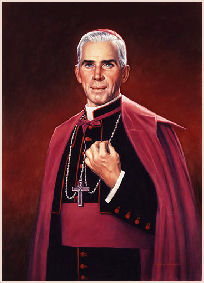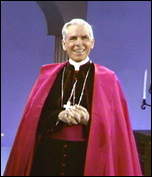
|
|
|
|
|
|
|
|
|
|
|
|
|
|
|
|
|
|
|
|
|
|
|
|
|
|
|
|
|
|
|
|
|
|
|
|
|
|
|
|
The Emmy




In 1930 Sheen began his broadcast career, hosting the Sunday evening Catholic Hour program on NBC Radio. In the 1940s he performed some religious services on television, and in 1948 he was guest speaker on the television program Television Chapel on WPIX in New York. Director Edward Stasheff remembered for Television Quarterly, "His whole technique was the magnetic effect of the way he looked into the camera. I hate to use a cliché, but the word is 'telegenic.' He was made for the medium."
In 1952 Milton Berle owned Tuesday night television with his 8 p.m. show, Texaco Star Theatre. The small DuMont network decided to put Sheen on the air opposite Berle as something of a sacrificial lamb, thinking a program with no potential may as well be on in a time slot with no chance. Life is Worth Living premiered on February 12, 1952, with the Bishop Fulton Sheen appearing in a long cassock, a gold cross and chain on his chest, a long purple cape and a skull cap, speaking from a set designed to look like a rectory study before an audience at the Adelphi Theatre in midtown Manhattan. The half-hour program consisted of a one-minute commercial for Admiral, followed by a 28-minute talk delivered without notes or teleprompter by the bishop, ended with a two-minute peroration and the sign-off "God love you," followed by another one-minute commercial for Admiral. This formula proved to be a success.
Sheen's talks were never straight appeals for loyalty to the Catholic church, but universal in nature, designed to appeal to people of any faith. "Starting with something that was common to the audience and me, I would gradually proceed from the known to the unknown or to the moral and Christian philosophy," he is quoted as saying in his posthumously published biography, Treasure in Clay. "When I began television nationally and on a commercial basis, I was no longer talking in the name of the church."
Popularity Increases
Initially, Life is Worth Living aired on only three stations nationwide. The show proved popular with audiences, however, and immediately began cutting into the ratings of Berle and Frank Sinatra, who had a Tuesday night show on CBS. Within two months Sheen's show was seen on 15 stations, and the bishop was overwhelmed with fan mail and requests to sit in the studio audience. NBC even tried to lure him away from DuMont at one point, but loyalty bid the bishop decline. At the 1952 Emmy Awards, Sheen defeated Edward R. Murrow, Lucille Ball and Arthur Godfrey for the title of Most Outstanding Television Personality. Upon accepting his award, he said, "I wish to thank my four writers, Matthew, Mark, Luke and John."
Eventually Sheen's program was seen by 20 million viewers on 123 stations. His fame grew along with his audience, and one of the things he became known for was performing conversions to Catholicism of well-known people, including Fritz Kreisler, Heywood Broun, Clare Boothe Luce, Henry Ford II and Louis Budenz. He also attracted attention for his political views, and at various times drew heat from both conservatives and liberals. He supported the anti-communist Franco in the Spanish Civil War, while conceding the dictator's fascism; he also defended corporal punishment in schools and spoke out against Freudian psychology. Following the reforms of Vatican II - which Sheen advised on mission problems - he spoke out against poverty and nuclear war, and alternately opposed and supported U.S. involvement in the Vietnam War.

| Archbishop Sheen and Cecil B. DeMille Receiving Freedom Award |
| Vice President Richard Nixon, (second from right), and film producer Cecil B. DeMille, (R), hold the Freedoms Foundation Award presented to DeMille in ceremonies at Valley Forge, where 800 awards worth $100,000 were announced by the Foundation. At left is Kenneth D. Wells, President of the Foundation, and next to him is the Reverend Fulton J. Sheen, Catholic Bishop honored with an award for his television program, Life Is Worth Living. DeMille was cited for his public address, "Silent Voices." |
Life Dates | Visitors |
Museum
| Special People |
Holy Mother Mary
St. Mary's Church |
Become a Volunteer | Buy a Book |
Museum Shop
How to Find Us | Our Future |
Our Beginnings | Photo Gallery
| Links | Personal Testimonies
Calendar of Events | Bishop Sheen Quotes |
Inspirational Messages |
Contact
Us | Home
